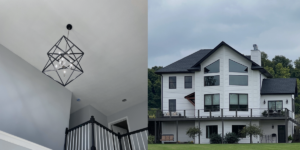Deck painting is one of those jobs that every family does when they want to change the look of their house and deck. It is best to paint your deck in the spring when temperatures are warm (60-80 degrees).
While painting a deck is a creative idea, there are some things you should be aware of. We’ll go over what to do when painting a deck, as well as the do’s and don’ts, tips, and steps to painting a deck. Trust me, it’s not as simple as it appears—let’s get started!
Deck Painting
Deck paint is also referred to as staining. If you have a wooden deck, you know how difficult it is to make that natural look pop! Cleaning with a pressure washer, regular repairs, and staining are all ways to keep your wooden deck in good condition.
While the deck can be considered a project, several steps must be taken to ensure that it is in good condition. Scraping away the old paint that has been scraped away is one way to maintain your deck. Smoothing out rough spots ensures a smooth deck ready for painting. The deck painting procedure is outlined below.
Deck Painting Process
You’re ready for your painting job; Let’s have a look at the steps you should take to get the job done-
Step 1: Washing
Painting a clean deck is as simple as painting on any other clean surface. A clean deck ensures that the paint is smooth and free of bumps caused by dust, pebbles, and leaves. Cleaning a deck necessitates the use of a pressure washer, garden hose, scrubbing brush, and broom. Here are some tips to keep in mind while washing the deck.
- Deck Cleaner: Get an all-purpose deck cleaning solution for washing to remove dirt, dust, and debris. It is essential to check any recommendations for the deck cleaner. Most of the time, the stain manufacturer would suggest a good deck cleaner recommendation.
- Wood brightener: Wood bleaching agents in wood brighteners lighten stains and dark splotches. It brightens the wood grain and aids in the removal of stains that would otherwise sip on the new stain application. It is commonly used to repair bled-not-painted wood decks.
- Mold: It is advisable to spray mildewcide cleaner before painting, especially if the deck has mold.
- Pressure washer: A pressure washer removes all of the dirt specks and debris from the deck. It thoroughly cleans the deck and removes stubborn stains. However, you must exercise caution when applying pressure to the wood. By using high pressure, large chunks of wood can be extracted from the deck. While maintaining the deck, a brush is used to scrub the deck and a garden hose is used to rinse the cleaning solution.
Step 2: Scraping
Scraping the old peeling paint is important before repainting the deck. Removing rough patches and sanding smooth old paint is essential to ensure the deck is smooth and ready for repainting. Here are some things to consider while scraping and sanding a deck.
Brush: Sweeping the deck helps scrape out loose paint on the deck. A wire brush helps remove old loose paint, but it might not do a good job.
Paint Scrapers: Using paint scrapers is essential to paint removal without gouging the wood with a blade.
Sanding: After all of the paint has been scraped off, the wooden deck will have bumps and grooves; sanding these down makes the wooden deck smooth and ready for repainting. To avoid sticking to the sandpaper while sanding, make sure the deck is intact and all the nails are in place.
Step 3: Painting!
The last step is to paint the deck. When the deck has been properly prepared and is clean and smooth, the next step is to open a can of paint. Painting, like the other two processes mentioned above, has some hints and insights.
- Get the right tools– The right tools get the job done to perfection. They include a paint roller, stain pads, and brushes.
· A roller is a great tool for applying new paint to the deck. It is also simple to use due to its handle; you can use it while standing up. It is the best painting tool because it applies a uniform coat of paint.
· Brushes can also paint a good coat, but their coat may not be uniform. Brushes should be used on areas that the roller cannot reach. Brushes are also designed for small or thin surfaces such as railings.
· Stain pads have foam, which helps in applying paint to non-painted wood.
- Uniform house– Even as you paint your deck, don’t forget about other parts of the house, like the garage. A painter’s tape helps unify the deck’s color with the rest of the house, giving it an excellent finish.
- Deck underside- Don’t forget to paint the underside of the deck as well as the top. Paint protects the wood from moisture and pests, keeping it in good condition for longer. When all sides of the deck are not sealed and painted, the deck can be compromised, so make sure you cover all sides of the deck.
You now understand the entire deck painting process, but how do you know when your deck needs painting, what type of paint it requires, and how to best handle it? Here are some things to keep an eye out for:
- Damage: Damage to a deck can indicate whether it needs to be repainted, restructured, or rebuilt. Finding out what kind of damage the deck has can quickly help you identify the deck’s solution and the best deck paint. Use stronger paint to fill in cracks in the wood deck that cause inconsistencies.
- Weather: Different types of weather have different effects on the deck. Choosing the right deck paint will depend on knowing what kind of weather the deck is subjected to. UV-resistant paint is recommended if you live in a hot climate. A UV-resistant paint will keep the deck from fading; if the deck will be exposed to rain, paint with a built-in grip is recommended.
- Usage: The paint should complement your deck and its use, depending on how you use it. Where there is a lot of foot traffic on the deck, slip-resistant paint is best. Paint that prevents splinters is recommended if children run around the deck a lot.
Picking Decking Paint
The choice of deck paint is just as important as the painting itself. The distinction between exterior and interior paint is critical to grasp. Exterior paint is primarily used to paint surfaces outside the home and contains components that protect your surfaces from elements that could damage your painted surfaces. Interior paint, on the other hand, is primarily used to decorate your home.
Factors to Consider When Picking Deck Paint:
Type of paint.
Your deck can be painted with one of two types of paint. The first type of paint is water-based paint, also known as acrylic paint. This paint is used to protect the exterior surface of objects. Acrylic paint’s water-based properties are one of the reasons it is used on a daily basis. When changing the color of your paint, it is simple to remove. The oil-based paint, on the other hand, is long-lasting and works from the inside out until it is applied.
Oil-based paint seeps into the deck board and protects it from the inside due to its oil-based properties. Another important feature of oil-based paint that makes it ideal for deck surfaces is that it is difficult to clean with water. Spirit is frequently used during the removal process. If such compounds are ineffective, the painted surface can be sanded and the paint removed.
Type of existing paint
The existing paint has an impact on the color you choose for your entire deck. If the previous paint was bright, think about your options and choose a dull color. If the previous color of the deck boards was bright, you might want to consider a dull color to change the appearance of your deck. Understanding the type of old paint that was used on the deck could help you choose a new coat. For example, if the deck was previously painted with oil-based paint, use water-based paint instead, and vice versa.
The goal is to keep the wood in good condition so that it does not deteriorate. Using a primer just before applying paint is a common practice when painting. The color of pre-existing paint influences whether or not you need to use a primer during the painting process. Depending on the pre-existing paint, you may need to apply two coats to achieve an even look before applying for the final paint job. If the primer application did not achieve an even look on the surface, you may need to sand the surface with a power sander to speed up the sanding process and save time.
Type of surface used to make the deck.
The type of paint you will use to paint the deck is heavily influenced by its condition. The majority of decking materials are pressure-treated wood, which can withstand higher temperatures and other elements for an extended period of time. When using bare wood on the deck, it is critical to apply paint to help protect the wood from the elements.
Before you begin painting, you should go to your hardware store and get professional advice on the condition of your entire deck board. Getting advice from your hardware store can help you understand the best paint for your deck. To avoid peeling paint ruining the appearance of your deck, consider the material used to make the deck boards.
Personal preference
The type of paint you use is heavily influenced by personal preference. You should occasionally paint your deck to keep it in good condition. Choosing colors that complement your color preferences may influence the type and color of paint you use.
Stain vs. Paint
Most people wonder what the advantages of staining your deck are when compared to painting the entire deck. Before we get into the differences, it’s important to understand the two definitions. Staining entails using a wood preservative to extend the life and quality of your deck. Various stains are used during the staining process.
Acrylic, oil-based, and gel-based stains are the most common. Painting, on the other hand, entails using a paintbrush to apply color elements to surfaces for decorative purposes. Before painting a deck, it is critical to consider the paint components to ensure that your entire deck is protected from natural elements such as UV rays and rain.
Advantages of using stain
- It is more cost-effective to use stain on your deck compared to painting the entire deck.
- The use of stain gives a more natural and aesthetically pleasing touch to your deck than painting.
Advantages of using paint
- Paints have a variety of colors to be used for this reason, and it gives you the option of using different colors on your deck.
- Maintaining paint jobs is easier than maintaining stains. If a section of the painted deck is damaged, only the damaged section is painted. When using a stain, however, you cannot paint the edges while leaving the other parts unpainted in case of damage. To achieve a uniform appearance, apply the stain to the entire deck.
For more information on deck painting, please contact The Ohio Painting Company at 978 Irving Ave., Dayton, OH 45419. To schedule an appointment, call (937) 409-4443 today.






